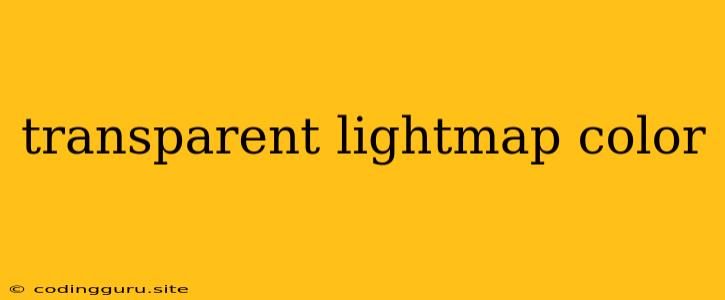Understanding and Utilizing Transparent Lightmap Colors
In the realm of 3D graphics, especially in game development, transparent lightmap colors play a crucial role in achieving realistic lighting and shadows. These colors are often overlooked, but understanding their function is essential for crafting visually appealing and immersive environments.
What are Transparent Lightmap Colors?
Transparent lightmap colors are essentially colors with an alpha value, representing the level of transparency. This alpha value determines how much light passes through the surface. For example, a fully transparent color will allow all light to pass through, while a fully opaque color will block all light.
Why Use Transparent Lightmap Colors?
Transparent lightmap colors offer a plethora of benefits when it comes to optimizing lighting and shadows:
- Enhanced Realism: They allow for more realistic lighting and shadows, especially for objects like stained glass, translucent materials, and foliage.
- Performance Optimization: Instead of rendering individual light sources for each transparent object, transparent lightmap colors can be used to bake light information directly into the object's texture, significantly improving performance.
- Artistic Expression: They provide artists with greater control over lighting and visual effects, enabling them to create unique and expressive lighting scenarios.
How to Implement Transparent Lightmap Colors
The implementation of transparent lightmap colors varies depending on the specific game engine or software you're using. However, here's a general guideline:
- Material Setup: Ensure that the material you're using supports alpha transparency.
- Texture Creation: Create a texture with an alpha channel that defines the transparency of your object.
- Lightmap Baking: During the lightmap baking process, configure the software to utilize the alpha channel of the texture. This allows the lightmap to incorporate the transparency information.
- Material Assignment: Assign the texture with the transparent lightmap colors to your object's material.
Practical Applications
Transparent lightmap colors have numerous applications in game development:
- Stained Glass Windows: They can create stunningly realistic stained glass windows by allowing light to pass through them in a controlled manner.
- Foliage: Transparent lightmap colors can be used to simulate the scattering of light through leaves, creating a more natural and immersive experience.
- Water Effects: They can be combined with other techniques to create realistic water effects, allowing light to refract and reflect through the water surface.
- Volumetric Effects: Transparent lightmap colors can be used to create volumetric fog and other effects, enhancing the atmosphere of the game world.
Tips for Utilizing Transparent Lightmap Colors
- Optimize Alpha Channel: Carefully define the alpha channel of your texture to avoid unwanted artifacts or performance issues.
- Lighting Setup: The placement and type of light sources will significantly impact the visual outcome of transparent lightmap colors. Experiment with different light configurations to achieve the desired effect.
- Texture Resolution: Higher resolution textures will generally produce better results but come at a cost in terms of memory and performance.
- Performance Considerations: Be aware of the potential performance impact of transparent lightmap colors, especially when dealing with large and complex scenes.
Conclusion
Transparent lightmap colors are a powerful tool for achieving realistic and visually stunning lighting and shadows in 3D graphics. By understanding their principles and applying them effectively, game developers can create immersive and memorable environments. Utilizing transparent lightmap colors can elevate the visual quality of your projects, allowing you to create scenes that capture the beauty and intricacy of real-world lighting.
